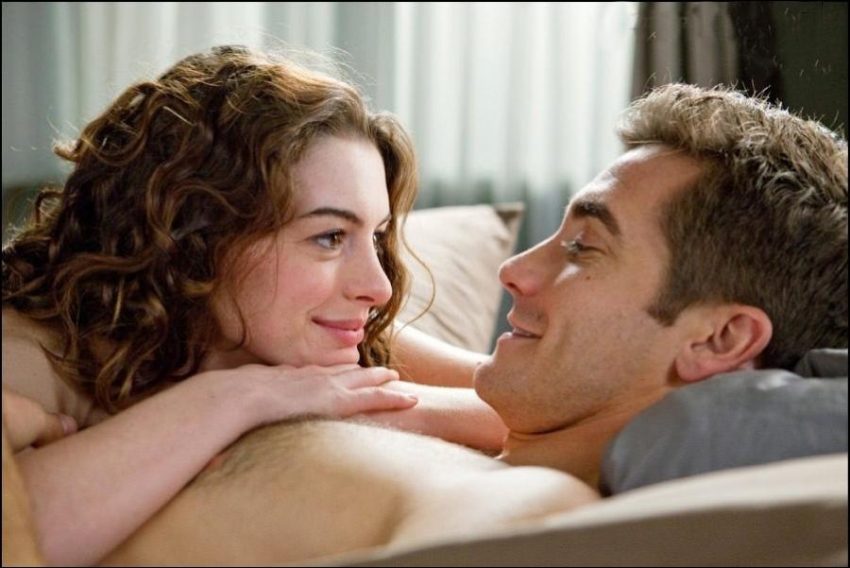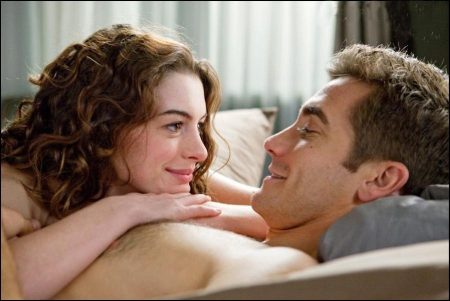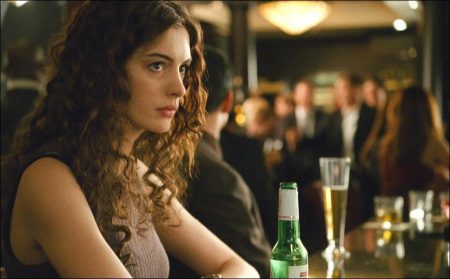Jake & Anne / Jamie & Maggie
“I think one of the joys of doing what I do,” confides Zwick, “is finding and working with people whose gifts are only coming into their full flower; I think that can be said of both Jake and Annie’s work in Love & Other Drugs. I was the ‘midwife’ to that moment, and allowed it to happen. And they were not just extraordinarily brave and open with me; they were remarkable with each other.”
Zwick says the roles of Jamie and Maggie represent significant steps for the two actors. “[As Jamie] Jake’s not just romantic, interesting and charming, he’s enormously funny. Jake’s sense of humor is nothing new to those who’ve known him socially, but up to now we’ve never quite had the opportunity to see that on film. He has a great leading man quality and is extraordinarily at ease, and that comes of maturity and experience. Jake’s work in this film allows us to witness a younger actor become a leading man, and that’s very exciting for a filmmaker and, I think, an audience…
“Anne has long been taking extraordinary risks with her performances in films like Rachel Getting Married [for which she was Oscar-nominated] and through her work in Shakespeare in the Park,” Zwick continues. “Maggie in Love & Other Drugs is another in a series of brave choices she has made again and again. Anne reveals yet another aspect of her talents, takes more risks and pushes more of her boundaries.
“I think there’s great pleasure to be taken not only in experiencing these moments in Jake and Anne’s professional lives but also seeing how they combust on screen with one another. These are two actors who worked opposite one another on Brokeback Mountain, who knew each other, who had real fondness and trust and confidence and faith in each other as well as great delight.”
Gyllenhaal’s Jamie is the black sheep in a successful family. He’s the ultimate seducer, and would have been perfectly happy to float through life minus the burden of responsibility or connecting to anyone…until he meets Maggie. “He’s bright but a bit self-destructive,” says the actor. “He’s content to be successful with his life as a salesman of a revolutionary drug – a job for which he’s perfectly suited – and continue to succeed at fake connections. He’s an expert at those because he’s a great performer.”
But Jamie’s shell of charm and carefree seduction begins to crack after he meets Hathaway’s equally free-spirited Maggie. Maggie is a fine arts painter who is finding it increasingly difficult to continue her work, due to her being afflicted with early-onset Parkinson’s disease, a degenerative disorder of the central nervous system that often impairs the sufferer’s motor skills and speech. “When Maggie meets Jake, she is at a transitional moment in her life,” says Hathaway. “She hasn’t accepted her challenges, and more importantly, she hasn’t been able to accept herself.“
Hathaway and the filmmakers made sure that Maggie’s condition shapes the character’s attitude and was always in the service of the character. Her illness provide Maggie with unexpected richness and poignancy, especially with her relationship with Jamie, which began as casual sex and evolved into something so much more.
“I loved how seemingly fearless Maggie is,” says Hathaway. “I was moved by the challenges she faces and by the façade she presents to the world, as an idealized sex goddess who is fine with everything and anything. But there’s an aching and yearning there; she’s scared and vulnerable, and a wonderful person under all of that. As an actress, you dream of opportunities to explore those things.”
Hathaway notes that her previous collaboration with Gyllenhaal, on Brokeback Mountain, was a critical factor in their work together on Love & Other Drugs. “We learned [on Brokeback Mountain] that were really good scene partners, and good at listening to one another. We go much deeper with that in this movie.”
The actor’s professional rapport was a key factor in creating the film’s uninhibited love scenes, which bring both comedy and heart to the Jamie-Maggie relationship. “Sexual and intimate situations can be very funny,” says Zwick. “I think audiences will be surprised by the revealing situations in which we discover that humor. Chemistry is something that is very hard to talk about and, like love and attraction, it is unpredictable; but you know it when you see it. It’s not just that Anne and Jake are intrinsically funny and deeply smart and emotional not to mention attractive, but they share another quality that I think is possibly more important — they’re both very brave. Some of the scenes and some of the choices that I asked of them demand that bravery, and the more I saw it the more I feel willing to ask it.”
Love & Other Drugs also stars Oliver Platt as Bruce Winston, Jamie’s beleaguered boss, who is desperate to relocate to more fertile sales territory in Chicago; Hank Azaria as Dr. Stan Knight, an ethically-challenged physician who’ll write a prescription for whatever ails you; Josh Gad as Josh, Jamie’s successful younger brother and roommate; and Gabriel Macht as Trey, a successful pharmaceuticals salesman whose competition with Jamie is complicated by his earlier relationship with Maggie.
Jamie’s boss and mentor Bruce Winston, “takes Jamie out into the field and completes his training,” says Platt. “Bruce immediately becomes aware that Jamie is extremely bright, instinctive and talented, although not necessarily in the most conventional ways, and sees Jamie as Bruce’s ticket to a coveted sales slot in Chicago.”
Hank Azaria’s Dr. Stan Knight is Jamie’s prime sales target. Azaria describes Stan as “a successful family practitioner who has become really jaded. He began his career as a very idealistic guy who wanted to be a doctor and a healer but over time, has been ground down by the system – seeing fifty patients a day, prescribing like crazy and essentially feeling like the shill of the pharmaceutical companies. It may seem as if he’s got it all going for him, but he’s become an unhappy, prurient, thrill-seeking and self-serving guy whose favorite part of being a doctor is being rich and getting laid.” While Dr. Knight knows Jamie, and inadvertently introduces him to Maggie, it’s not until the young salesman starts peddling Viagra that the bond between the two is solidified. “For middle-aged guys who want to drink and run around with a lot of different women, you couldn’t ask for anything better that Viagra,” Azaria laughs.
Jamie’s brother Josh plays a key role in the former’s life. As Josh Gad observes, “Jamie has always been the black sheep, but he is much cooler—hey, he’s Jake Gyllenhaal! So when Josh is thrown out of his house by his wife, he comes to Jamie like this wounded deer that Jamie needs to help back up on its feet, older brother to younger brother. But Josh gets under Jamie’s skin enough for him to constantly beat on him–much like any good sibling rivalry. It was a lot of fun discovering this great relationship.”
Gabriel Macht’s Trey Hannigan is the top local sales rep for a competing product and firm. Trey is not happy with Jamie’s emergence as a rising star on the Big Pharma scene, or with Jamie’s burgeoning relationship with Maggie, with whom Trey recently had a deep love affair. “Trey is married and has two kids,” notes Macht, “and while he’s now back on the straight and narrow, he continues to care deeply for and feel protective of this young woman who’s changed his life.”
The Rise of Big Pharma
Love & Other Drugs is set in the late 90s, a moment, says Zwick, “when the fabric of American life changed forever” because for the first time, drugs became commercialized, via ads in magazines and on television. Drugs were now being sold directly to consumers. At the top of the sales and advertising charts was a little blue pill called Viagra, a new treatment for erectile dysfunction. Viagra became a phenomenon was that pure gold for the company marketing and selling it, Pfizer, and for its legions of sales reps crisscrossing the country extolling its virtues. Viagra’s blockbuster sales trigger Jamie’s ascension to the top of the heap as a Big Pharma sales rep.
“The commercialization of drugs is commonplace now, but then it was revolutionary,” Zwick explains. “I think that phenomenon bespeaks deeper cultural trends that are part of Love & Other Drugs’ story about a guy who wants his piece of the greatest accumulation of wealth in modern memory, and the way he’s going to get it is to partake in something that is happening for the first time in American culture—the selling of these drugs. Then, because of Jake’s relationship with Maggie, he goes deeper into the world of medicine and drugs and the different strands of the story knit together and, I hope, resonate off each other.”
Jamie Reidy, author of the film’s source material, has first-hand experience with the pharmaceutical industry’s cutting-edge marketing tactics. After spending time on the set of Love & Other Drugs, Reidy was impressed by the film’s focus and attention to detail. “The production design of the medical offices was spot-on – and Jake and Oliver look exactly like real drug reps,” Reidy says. “A moment when I noticed that something was a bit off, like when Oliver was carrying a briefcase into the office – a person of Bruce’s position would never carry a briefcase – I mentioned to Ed [Zwick] and on the very next take the briefcase was gone.”
To help prepare Gyllenhaal for the role, Reidy met with the actor several times before production. “Jake was great about asking advice on how a drug rep would handle certain situations,” says Reidy. “For example, he didn’t understand how a rep could walk in cold into an office and approach the receptionist to try and leave samples or talk to a doctor. I told him it is just like being in a bar and walking up to a woman you don’t know. We talked about the lean-in – that when you walk to the reception counter, you don’t just stand there, you lean in, just like you would when you talk to a woman at a bar.”
While Gyllenhaal consulted with Reidy, Anne Hathaway received advice from another real warrior in the drug wars, Lucy Roucis, a professional actor with Parkinson’s disease (diagnosed when she was in her late twenties) who now works in Denver with an acting troupe called PHAMALY (the Physically Handicapped Actors and Musical Artists League, Inc.). In the film, Roucis plays a comedian with Parkinson’s whose shtick at a convention for Parkinson’s patients helps Maggie begin to come to terms with her condition.
Also critical in defining the characters and their world was the work of director of photography Steven Fierberg, ASC, production designer Patti Podesta and costume designer Deborah L. Scott. Podesta describes how “Maggie’s loft is the complete opposite of the corporate, sterile world that Jamie’s been dumped into. It’s a big, open factory space with large windows – complex and boundless – where she seems to be almost squatting. It’s a free space, yet it’s a kind of limbo because as her disease progresses, she won’t be able to live there [without assistance]. Ed and I talked a lot about how the medical spaces in the film would be sort of cold and rectilinear, not soft and round so that when we get to Maggie’s space we’d see every kind of shape. Jamie is attracted to her home, like he’s attracted to everything that she offers – this world that he’s never really been opened up to.”
While Jamie’s tailored business suits are a type of uniform, Maggie’s outfits are a more self-conscious expression of her individuality. “Maggie’s an artist and she’s quirky,” says Deborah L. Scott. “You imagine her having collected whatever pieces of clothing she liked or found; she doesn’t have much money. A lot of her things come from thrift stores and a few are vintage pieces – some of it from my own closet. It’s fun to dress Maggie, because you have no boundaries like you have with Jamie. She’s not someone whose outfits you can create on paper. It’s really hard not to let a quirky character like that get over the top. Initially we explored what Maggie having short hair that was tinted blue, but Anne is so gorgeous, we all decided early on that Maggie should be gorgeous.”
Scott further notes that Jamie’s back to the basic clean-cut well-tailored suit fits into an established formula for drug reps. “But Jamie is a complex character that undergoes a subtle transition in the film,” she notes. “While he starts off a bit lackadaisical about the way he dresses, he slowly takes on the uniform of a pharma rep and then takes it a step further to where he kind of owns it before realizing that’s not really who he is. “
Love & Other Drugs was shot in the fall of 2009 entirely in and around Pittsburgh, Pennsylvania. The first week of shooting coincided, without incident, with the G20 Summit hosted by President Obama. Over the past two decades, after the collapse of the steel industry, the city completely reinvented itself. Pittsburgh is now a center of the U.S. medical industry, with vibrant biotech research companies, big universities, and impressive resources. Says Brugge: “I’d worked in the city before when I produced and directed my film The Clearing and I’d come to really like Pittsburgh and the fantastic work ethic of its people. We were able to work with an entirely local construction, grip and electric departments; we brought in very few people in order to make Love & Other Drugs.”
After principal photography wrapped in Pittsburgh, Zwick and his post-production teams worked for months before the film was ready for its initial previews and screenings. The results met or even surpassed everyone’s expectations, including the film’s director / co-writer / producer: “What’s most pleasing is how people relate to it,” says Zwick. “They see something of themselves in the Jamie-Maggie relationship, which describes something people have, want to have, or something they once had and lost. When you tell a story that’s this personal, this kind of response is very gratifying.”
Love and Other Drugs (2010)
Directed by: Edward Zwick
Starring: Anne Hathaway, Jake Gyllenhaal, Judy Greer, Jaimie Alexander, Hank Azaria, Kate Jennings Grant, Katheryn Winnick, Kimberly Scott, Nikki Deloach, Natalie Gold, Tess Soltau, Constance Brenneman
Screenplay by: Marshall Herskovitz
Production Design by: Patti Podesta
Cinematography by: Steven Fierberg
Film Editing by: Steven Rosenblum
Costume Design by: Deborah Lynn Scott
Set Decoration by: Meg Everist
Art Direction by: Gary Kosko
Music by: James Newton Howard
MPAA Rating: R for strong sexual content, nudity, pervasive language, and some drug material.
Distributed by: 20th Century Fox
Release Date: November 24, 2010





